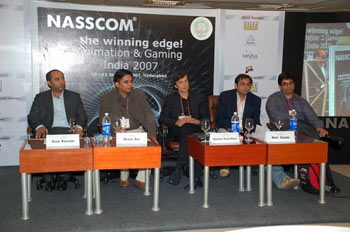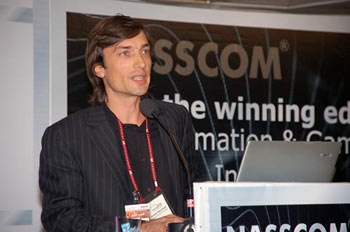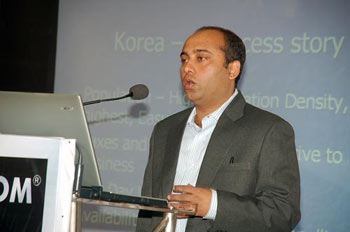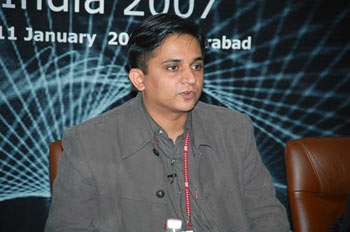NASSCOM Animation & Gaming India 2007: Session Wise Coverage

Looking at the way that gaming is growing in India it is obvious to compare the scenario here to the big markets such as Korea and China. The first discussion at the Gaming track at the NASSCOM Animation and Gaming India 2007 conference was on whether India would follow Korea and China on the gaming front.
Discussing the topic were Indiagames CEO Vishal Gondal, Kreeda Games India CEO Quentin Staes Polet, Microsoft Product Manager for Xbox 360 Vivek Kulkarni and Zapak Digital Entertainment COO Rohit Sharma. The session was chaired by Dhruva Interactive CEO Rajesh Rao.
The first question that was raised to the panel by Session Chair Rajesh Rao was whether India was all set to follow China and Korea in gaming? If yes, then why and if no, then why not? Speaking first, Kreeda Games India‘s Quentin was of the opinion that the market in India is very ripe. The rapidly expanding broadband penetration in India (@56% per quarter), increased sales of personal computers and the mushrooming of cyber cafes all over the country (there were 105,000 cyber cafes in India in 2005, 50% of whose revenue were generated directly or indirectly from games) are some of the positive signs that India is game.

“The problems of concern is the lack of information about who the gamers in India are, no proper channels of distribution, high cost of bandwidth and latency, minimal Government support, lack of payment and revenue systems and no established business model for gaming companies. What India can do is follow models which are prevalent in China and Korea where people have multiple options such as subscription, one time free, metered usage and the likes” shared Quentin.
“Again in terms of comparing India with China, the thing about China is that the government in China supports Gaming Cafes because it recognizes that gaming has the ability to bridge the digital divide as well as contribute to the economy” he added.
Airing his views on the same, Rohit said, “In China the people are actively into gaming.It is part of the mass entertainment culture and there are over 200000 cafes encouraging a cyber culture and since this, so there is also a special committee for Cyber Culture Affairs. S.Korea is the gaming content factory of the world which encourages community building with over 800 studios. 90% of Korea has broadband connectivity at home and the government like China is very supportive of this industry.”

According to Vivek Kulkarni it is not the question of if India will follow China, Korea, but when and how. The gaming market in Korea was $1.6 Billion in 2006 and will grow by 40% in 2010. One of the catalysts of this is the broadband connection speed which is 50 mbps and also broadband penetration which is 79%. Korea has a culture of adaptation of new technology and trends which explains the impetus to gaming and also localized content. Vivek said, “This is the right time for India to get into the market with options such as broadband, retail changes and the lowest global age of 24 being the advantages.”
“The problem is that we don‘t know what the youth like doing. The youth is what will drive this market, thus it is essential to know what they like and dislike. 95% of the market in India is pirated which shows that people want to play. This can be compared to the video cassettes piracy a few years ago before cable TV came into existence” commented Vishal Gondal.
Some of the issues that need to be dealt with, are duties and subsidies of consoles since they play a large role in making consoles available to the players
Summarizing the answer to the question, Rajesh said “The key things are the hooks and triggers. Time available for entertainment gets limited with various mediums of entertainment, hence the kind of content that is developed has to be immersive and strategies for attracting players have to be thought of”
The next question that arose was ‘How does one connect with the playersd and how do u engage and compel?‘ Zapak‘s COO Rohit Sharma believes that there is a gaming market but the right content has to be created which should be well marketed and distributed. Another question related to this was ‘Who is going to create it‘ and in response to this, Rohit said that It would be the studios and also outsourced work.
Kreeda‘s Quentin shared that, “In most markets 80-90% content is localized and that localization is a critical element” “Today‘s kids are exposed to and know what good and latest content is, therefore no second grade (hand-me-down) content will survive or do well.”

Rao posed the question of whether it would be a pre-dominantly an online or PC gaming market or consoles or will it be a combination of all or will it be a composite market? The answer to this, according to Kulkarni is that mobile gaming is the most popular now because of accessibility. He also forecasted a good growth for console hardware penetration and pricing improved and content got relevant over time. “Do we see it only as gaming or as digital entertainment? It is moving out from the niche to the mass audience.” Vivek further asked.
“Most of the people believe that broadband will drive gaming. Where as we at Zapak believe that Gaming will drive online. For example what is the bait today that induces a narrowband user to move to broadband. There is not enough compelling content for users to move to broadband content. Online gaming has all the right ingredients in terms of content, stickiness, community, e-commerce for users to embrace broadband” shared Zapak‘s Rohit Sharma emphatically.
“What‘s your take on mobile games sweeping people off their feet?” Asked session chair Rajesh Rao
As a pioneer in the field, Vishal Gondal said that mobile in India has had a greater impact than any other medium of gaming, but online gaming is more immersive. He said, “There is a close competition between online and mobile gaming. Console gaming is also moving towards online with Xbox Live. The standalone console will take time and will serve a certain strata of society”
According to Quentin media is converging. “We believe multiplayer gaming is the future. It will first start through on-line gaming and converge to mobile and perhaps even through your TV and console as the infrastructure improves. This is convergence. And we at Kreeda will focus on providing multiplayer games and building communities as a service to gamers with recurrent revenues and a direct relationship with our customers on a long term basis”.
Is the Indian market willing to pay? Asked Rao.
“People do pay for the content available on mobiles” opined Vishal Gondal. “The challenge is in making people see the value of online gaming and making them pay”
“We have ways to make people pay!” threatened Quentin good-naturedly, earning a laugh from the audience. But on a more serious note, his view was that people are willing to pay provided there is a good product, a good business model and good quality of service at the right price”. “The mode of payment/ collection is the issue that is faced by publishers today. Convenient, easy and transparent means of payment have to be made available”.
Talking about localization and pricing of games, Microsoft has made a game on Yuvraj Singh, thereby creating localized content. The duties are high therefore making it difficult to make profits. There is a strata that play console games but its not as large as that of online and mobile.
The session was concluded with the issue of the influence of games on kids. The reality is that games today are competing with TV. Another aspect that was looked at was how high quality education can be provided through entertainment models such as gaming.
Beyond the Great Wall, and even further beyond, by the coasts of the roaring Pacific, even as we speak or read about the topic of ‘Will India follow China and Korea in Gaming‘ hundreds of thousands of kids, teenagers and youngsters are thronging Gaming parlors, and as they enter the caf?©s, they move their attention from the mobile screens where they were in the middle of a game, turn their attention to the Monitors at the caf?© and continue the same game online, right from the stage they left it on the Mobile!
Will India follow China, Korea in Gaming?
Our take is Gaming‘s going to be big in India and while the dominant platforms‘ going to be Online, Mobile like China, Korea…. the culture, content and the manner in which the games are going to be consumed in our country will be different, unique and more in sync with the Indian mindsets
